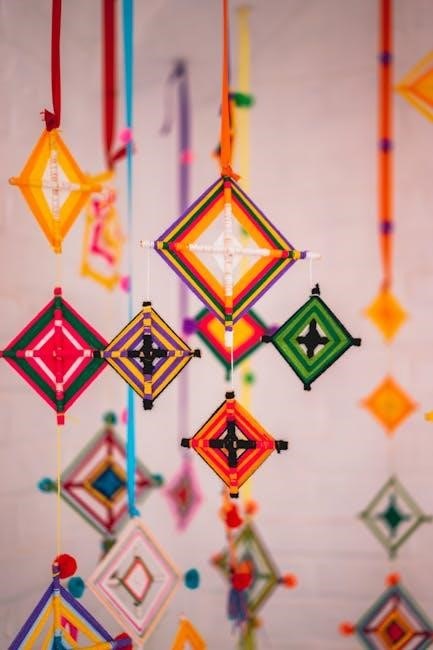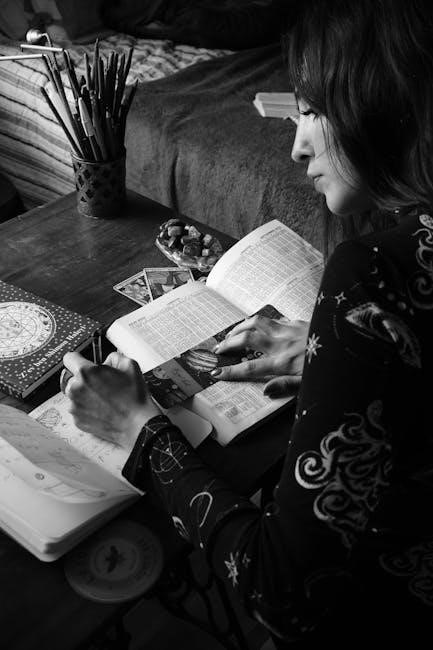Crochet chart symbols are visual tools used to represent stitches in patterns, making them easier to follow. These symbols transcend language barriers, allowing crafters worldwide to understand patterns effortlessly. They provide a clear, concise way to communicate complex stitch sequences, making crochet more accessible and enjoyable for all skill levels.
- They are essential for visual learners.
- They simplify intricate stitch patterns.
- They are widely used in international crochet communities.
Mastering crochet chart symbols opens up a world of creative possibilities, ensuring every stitch is placed perfectly for professional-looking results.

What Are Stitch Charts?
Stitch charts are visual diagrams that represent crochet patterns using symbols instead of written instructions. They provide a clear and concise way to illustrate the sequence and placement of stitches in a design. These charts are especially useful for complex patterns, as they allow crocheters to see the overall structure and relationships between stitches at a glance.
- They use standardized symbols to represent specific stitches.
- Charts are often used for motifs, lace, and intricate designs.
- They help crocheters track their progress visually.
Stitch charts are particularly beneficial for visual learners and international crafters, as they transcend language barriers. They are commonly included in patterns alongside written instructions, offering a complementary way to understand the design. By following the symbols and their arrangement, crocheters can recreate the pattern accurately and efficiently.

Importance of Stitch Charts
Stitch charts are vital for visualizing crochet patterns, enhancing clarity and reducing errors. They provide a universal language, making patterns accessible globally. Charts simplify complex designs, aid in tracking progress, and ensure accuracy, benefiting both beginners and experienced crocheters.
3.1. For Visual Learners
Stitch charts are particularly beneficial for visual learners, as they provide a clear and concise representation of crochet patterns. Instead of deciphering written instructions, crafters can rely on symbols to guide them through each stitch. This visual approach simplifies complex patterns, making it easier to understand the sequence of stitches and their placement. For those who struggle with written directions, charts offer a straightforward alternative, reducing confusion and errors. The ability to see the entire pattern laid out visually also helps in planning and executing projects, especially for intricate designs like lace or cables. Additionally, charts allow crocheters to track their progress easily, ensuring they stay on the right path. This method is especially helpful for beginners, as it builds confidence and improves their ability to follow patterns accurately. By transforming written instructions into a visual format, stitch charts make crochet more accessible and enjoyable for visual learners worldwide.
3.2. International Accessibility
Crochet chart symbols have become a universal language in the crafting world, bridging gaps between crocheters of different nationalities. Since these symbols are standardized and widely recognized, they eliminate the need for translation, making patterns accessible to everyone. This global accessibility is particularly valuable for designers who want to share their work with an international audience. Whether you’re in Europe, Asia, or the Americas, the symbols remain consistent, ensuring that the pattern is interpreted correctly. Many crochet communities and organizations, like the Craft Yarn Council, have embraced these symbols to promote unity among crafters. They also encourage collaboration and the sharing of ideas across borders. As a result, crocheters worldwide can enjoy a vast library of patterns, fostering a sense of connection and creativity within the global crochet community. This universal approach has made crochet more inclusive and enjoyable for crafters of all backgrounds and languages.

Standardized Crochet Symbols
Standardized crochet symbols are a set of uniform representations for various stitches, ensuring consistency across patterns and designers. These symbols, endorsed by organizations like the Craft Yarn Council, are designed to be clear and universally understood. They include visual depictions for basic stitches such as chain (ch), single crochet (sc), and double crochet (dc), as well as more complex stitches like treble crochet (trc) and Solomon’s knot. This standardization eliminates confusion and misinterpretation, making patterns accessible to crocheters of all skill levels. By using these symbols, designers can create patterns that are easily followed by crafters worldwide, regardless of language or regional differences; Standardized symbols also simplify the process of learning new stitches, as they provide a visual guide that complements written instructions. Many resources, including free PDF guides, are available to help crocheters master these symbols, ensuring a seamless crafting experience. This universal system has become essential for modern crochet, fostering creativity and precision in every project.

How to Read Crochet Charts
Reading crochet charts requires understanding the visual representation of stitches and their sequences. Charts are typically read from bottom to top, with each row or round represented by a line or symbol arrangement. The starting point is often marked with an arrow, number, or triangle, indicating where to begin. For right-handed crocheters, charts are usually read from left to right, while left-handed crafters may reverse the direction. Each symbol corresponds to a specific stitch, and their placement shows how stitches are worked in relation to each other. Rows and rounds are numbered or marked to guide progress. Pay attention to repetitions, increases, and decreases, as these are often indicated by symbols or patterns within the chart. Practice and familiarity with standardized symbols will enhance your ability to interpret charts accurately. Using a free PDF guide or reference chart can help decode symbols and improve your skills in reading crochet charts efficiently.
- Start from the indicated beginning point.
- Follow the flow of symbols for stitch placement.
- Refer to a symbol key or guide if needed.
Mastering this skill will make crocheting from charts a breeze, especially for complex patterns or international designs.

Advantages of Using Stitch Charts
Stitch charts offer numerous benefits for crocheters, enhancing the overall crafting experience. They provide a clear visual representation of patterns, making it easier to track progress and understand complex stitch sequences. This visual aid is particularly helpful for visual learners, who can grasp the pattern layout instantly. Charts also transcend language barriers, making crochet patterns accessible worldwide. They reduce the need for lengthy written instructions, minimizing confusion and errors. Additionally, charts allow crocheters to see the finished design, aiding in project planning and customization. For intricate patterns or motif-based designs, charts are indispensable, as they clearly show stitch placement and repetitions. They also enable crocheters to work more efficiently, especially on large or multi-piece projects. Overall, stitch charts streamline the crochet process, making it more enjoyable and accessible for crafters of all skill levels and backgrounds.
- Enhanced visual understanding of patterns.
- Reduced errors and confusion.
- Global accessibility for crocheters.
- Efficient tracking of progress and stitch placement.
By utilizing stitch charts, crocheters can achieve professional-looking results with greater ease and confidence.
Common Crochet Chart Symbols
Crochet chart symbols are standardized representations of stitches, making patterns universally understandable. The most frequently used symbols include the chain (ch), slip stitch (sl st), single crochet (sc), half double crochet (hdc), double crochet (dc), and treble crochet (tr). Additional symbols represent specialized stitches like the crab stitch (reverse single crochet) and Solomon’s knot. Each symbol is designed to be intuitive, with visual cues indicating stitch orientation and placement. For example, a “V” shape often represents a double crochet, while a simple vertical line denotes a single crochet. These symbols are arranged in charts to illustrate the sequence and repetition of stitches, allowing crocheters to follow patterns visually. Understanding these common symbols is essential for interpreting crochet charts accurately and efficiently.

- Chain (ch): A foundational stitch.
- Slip Stitch (sl st): Used for joining or sewing.
- Single Crochet (sc): A basic stitch.
- Half Double Crochet (hdc): Slightly taller than sc.
- Double Crochet (dc): The most common stitch.
- Treble Crochet (tr): The tallest stitch in this group.
Mastering these symbols is key to working with crochet charts effectively.
Free and Premium PDF Resources
Accessing crochet chart symbols has never been easier, thanks to a wealth of free and premium PDF resources available online. Websites like Pretty Darn Adorable and the Craft Yarn Council offer downloadable guides that include standardized symbols and abbreviations. These PDFs are perfect for beginners and experienced crocheters alike, providing clear visual aids to master stitch charts. For those seeking more detailed or specialized resources, premium PDFs on platforms like Etsy or Ravelry offer comprehensive guides, including step-by-step tutorials and customizable charts. Many designers also provide printable charts tailored to specific patterns, ensuring you can follow along seamlessly. Whether you’re looking for basic stitches or complex motifs, these resources are invaluable tools to enhance your crochet journey.
- Free Resources: Websites like Pretty Darn Adorable offer free PDF guides with essential symbols.
- Premium Resources: Detailed guides on Etsy and Ravelry provide advanced tutorials and customizable charts.
- Specialized Charts: Designers often include PDFs tailored to specific patterns for easy reference.
These resources are perfect for visual learners and those seeking to expand their crochet skills.

Tips for Working with Stitch Charts

Working with stitch charts can enhance your crochet experience, especially when tackling complex patterns. Always start by reviewing the chart key, as it provides essential symbol definitions. Begin reading charts from the bottom up, as this is how patterns are typically constructed. Use a highlighter to mark your progress, ensuring you stay on track. For intricate designs, consider enlarging the chart for better visibility. If you’re left-handed, reverse the chart’s orientation to match your crochet direction. Practice interpreting symbols gradually, starting with simple charts before moving to more complex ones. Using stitch markers can help you identify key points in the pattern. Keep a printed copy of the chart handy to avoid switching between screens. By mastering these tips, you’ll find stitch charts to be invaluable tools for creating beautiful, professional-looking crochet projects with ease and confidence.
Crochet chart symbols are an invaluable resource for crafters, offering a universal language that transcends words. They provide clarity and precision, making patterns accessible to everyone, regardless of language or skill level. By mastering these symbols, crocheters can tackle even the most complex designs with confidence. The availability of free and premium PDF resources ensures that learning and referencing these symbols is convenient. Whether you’re a beginner or an experienced crafter, stitch charts empower you to create beautiful, professional-looking projects. Embrace the world of crochet chart symbols and unlock endless creative possibilities. Happy crocheting!